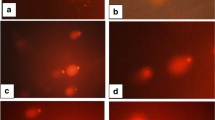Abstract
The effect of various hepatotoxicants on urinary taurine and urinary creatine has been studied in the rat. Several hepatotoxic agents, carbon tetrachloride, thioacetamide, galactosamine and allyl alcohol which all caused hepatic necrosis (sometimes accompanied by steatosis), resulted in a rise in urinary taurine and in some cases creatine, when administered to rats. Ethionine and hydrazine also raised urinary taurine but caused only steatosis and did not raise urinary creatine. Therefore urinary taurine and possibly creatine may be useful markers of liver injury and dysfunction. Liver taurine levels were also affected by some of the hepatotoxicants but in those cases where there was a rise in urinary taurine this could not be accounted for by the loss in liver taurine. It is suggested that the increase in urinary taurine is partly due to changes in protein synthesis and hence in sulphur amino acid metabolism caused by hepatotoxic agents. However, bromobenzene did not increase urinary taurine andα-naphthylisothiocyanate and lithocholate caused reduced levels. It is suggested that this lack of increase in urinary taurine may be due to depletion of glutathione or interference with the biliary system.
Similar content being viewed by others
References
Butler WM, Maling HM, Horning MG, Brodie BB (1961) The direct determination of liver triglycerides. J Lipid Res 2: 95–96
Chesney RW (1985) Taurine: its biological role and clinical implications. Adv Pediatr 32: 1–42
Cornish HH, Ryan RC (1964) A study of carbon tetrachloride VI. Aminoaciduria in response to carbon tetrachloride inhalation. Toxicol Appl Pharmacol 6: 96–102
DeMaster EG, Redfern B (1987) High-performance liquid chromatography of hepatic thiols with electrochemical detection. In: Jackoby WB, Griffith OW (eds) Methods in enzymology. NY Academic Press, New York, p 110–114
Dent CE, Walshe JM (1954) Amino acid metabolism. BMJ 10: 247–250
Durkin TA, Anderson GM, Cohen DJ (1988) High-performance liquid Chromatographic analysis of neurotransmitter amino acids in brain. J Chromatogr 428: 9–15
Ellman GL (1959) Tissue sulfhydryl groups. Arch Biochem Biophys 82: 70–77
Gartland KPR, Bonner FW, Nicholson JK (1988) Investigations into biochemical effects of region-specific nephrotoxins. Mol Pharmacol 35: 242–250
Gray JA, Nicholson JK, Creasy DM, Timbrell JA (1990) Studies on the relationship between acute testicular damage and urinary and plasma creatine concentration. Arch Toxicol 64: 443–450
Hirai T, Ohyama H, Kido R (1987) A direct determination of taurine in perchloric acid-deproteinized biological samples. Anal Biochem 163: 339–342
Jaeschke H, Kleinwaechter C, Wendel A (1987) A role of acrolein in allyl alcohol induced lipid peroxidation and liver cell damage in mice. Biochem Pharmacol 36: 51–57
Jollow DJ, Mitchell JR, Zampaglione N, Gillette JR (1974) Bromobenzene-induced liver necrosis. Protective role of glutathione and evidence for 3,4-bromobenzene oxide an the hepatotoxic metabolite. Pharmacology 11: 151–169
Kocsis JJ, Harkaway S, Santoyo MC, Snyder R (1968) Dimethyl sulfoxide: interactions with aromatic hydrocarbons. Science 160: 427–428
Kocsis JJ, Harkway S, Snyder R (1975) Biological effects of the metabolites of dimethyl sulphoxide. Ann NY Acad Sci 243: 104–109
Larsen BR, Grasso DS, Chang SY (1980) A rapid method for taurine quantiation using high performance liquid chromatography. J Chromatogr Sci 18: 233–236
MacDonald JR, Gandolfi AJ, Sipes IG (1985) Structural requirements for the cytoprotective agents in galactosamine-induced hepatic necrosis. Toxicol Appl Pharmacol 81: 17–24
Naftalin L, Sexton M, Whitaker JF, Tracy D (1969) A routine procedure for estimating serum gamma-gluamyl transpeptidase activity. Clin Chim Acta 26: 293–296
Rawcliffe L, Creasy DM, Timbrell JA (1989) Urinary creatine as a possible marker for testicular damage: studies with the testicular toxic compound 2-methoxyethanol. Reprod Toxicol 3: 269–274
Sanins SM, Nicholson JK, Elcombe C, Timbrell JA (1990) Hepatotoxin-induced hypertaurinuria: a proton NMR study. Arch Toxicol 64: 407–411
Siedel J, Mullering H, Ziegenhorn J (1984) Sensitive color reagent for the enzymatic determination of creatinine. Clin Chem 30: 968–969 (Abstr. 1)
Waterfield CJ (1992) The influence of foreign compounds on taurine levels: an in vivo and in vitro study. PhD thesis, University of London
Waterfield CJ, Turton JA, Scales MDC, Timbrell JA (1991) Taurine a possible urinary marker of liver damage: a study of taurine excretion in carbon tetrachloride-treated rats. Arch Toxicol 65: 548–555
Yoshida M, Hara I (1985) Composition of urinary metabolites and variation of urinary taurine levels in rats injected with chlorobenzene. Ind Health 23: 239–243
Yoshida S, Akagi R, Ubuka T (1989) Sulfate and taurine excretion in rats afterl-cysteine administration. Acta Med Okayama 43: 281–288
Zimmerman HJ (1978) Hepatotoxicity: the adverse effects of drugs and other chemicals on the liver. Appleton-Century-Crofts, NY
Author information
Authors and Affiliations
Rights and permissions
About this article
Cite this article
Waterfield, C.J., Turton, J.A., Scales, M.D.C. et al. Investigations into the effects of various hepatotoxic compounds on urinary and liver taurine levels in rats. Arch Toxicol 67, 244–254 (1993). https://doi.org/10.1007/BF01974343
Received:
Accepted:
Issue Date:
DOI: https://doi.org/10.1007/BF01974343




